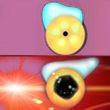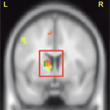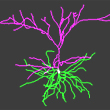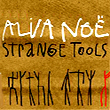Monday, 22 October 2012
Optogenetics: Neurons Controlled by Light

Among the many new techniques developed in the neurosciences in recent years, few have caused as much of a stir as optogenetics. This strange marriage between the sciences of optics and genetics allows the activity of entire populations of neurons in the brains of living animals to be controlled with a simple ray of light. Just a decade or two ago, such a technique, which is relatively non-invasive and accurate to within one millisecond, would have been unimaginable! (more…)
Emotions and the Brain, The Senses | Comments Closed
Wednesday, 17 October 2012
Learning How To Pique Curiosity

What is learning? What teaching methods are the most effective? Under what conditions do we remember information best? These are big questions, and the subject of continuing debate.
Neuroscientists continue to contribute relevant data to this debate, in particular as regards the conditions that help us learn and retain information best. In 2009, Min Jeong Kang’s research team published a brain imaging study that confirmed the importance of a well known but often under-utilized condition for enhancing learning: curiosity. (more…)
Memory and the Brain | Comments Closed
Monday, 1 October 2012
Like Strangers in Their Own Land
 Fewer than 100 cases of foreign accent syndrome, have been identified worldwide, but it is certainly one of the strangest things that can happen to anyone. From one day to the next, a person wakes up speaking with what sounds like an accent from another country.
Fewer than 100 cases of foreign accent syndrome, have been identified worldwide, but it is certainly one of the strangest things that can happen to anyone. From one day to the next, a person wakes up speaking with what sounds like an accent from another country.
But in fact, this similarity is merely random. Scientists now know that foreign accent syndrome is actually a particular kind of aphasia that produces slight alterations in the prosody of language. Listeners then perceive these unusual variations in the rhythm and meolody of the person’s speech as a foreign accent. (more…)
From Thought to Language | Comments Closed
Saturday, 22 September 2012
The 1001 Faces of the Neuron
 The kind of diagram used to represent a typical neuron with its specialized extensions (axon and dendrites) can make us forget the unbelievable variety of shapes that these nerve cells can actuslly have. If you don’t believe it, go take a look at the web site NeuroMorpho.Org (click the link below).
The kind of diagram used to represent a typical neuron with its specialized extensions (axon and dendrites) can make us forget the unbelievable variety of shapes that these nerve cells can actuslly have. If you don’t believe it, go take a look at the web site NeuroMorpho.Org (click the link below).
This site contains a database of more than 6600 digitally reconstructed images of neurons and their complex branching structures, and even lets you view them in 3D. This image database was compiled from contributions from over 60 laboratories worldwide that use a variety of methods of staining and neuronal tracing in their experiments. (more…)
From the Simple to the Complex | Comments Closed
Monday, 10 September 2012
Why You Are Not Just Your Brain
 In the introduction to their 1991 book The Embodied Mind, Francisco Varela, Evan Thompson, and Eleanor Rosch noted that as of that writing, the cognitive sciences had little to say about what it means to be human in the concrete situations of everyday life. This criticism was aimed directly at the prevailing paradigm, according to which the human brain worked somewhat like a computer, with input, information processing, symbolic representation, output, and so on.
In the introduction to their 1991 book The Embodied Mind, Francisco Varela, Evan Thompson, and Eleanor Rosch noted that as of that writing, the cognitive sciences had little to say about what it means to be human in the concrete situations of everyday life. This criticism was aimed directly at the prevailing paradigm, according to which the human brain worked somewhat like a computer, with input, information processing, symbolic representation, output, and so on.
In contrast, the approach proposed by Varela and his colleagues, to which they gave the name “enaction”, emphasizes how much our reasoning depends on our bodies and on the environmental context in which they are situated. (more…)
Body Movement and the Brain, The Emergence of Consciousness | Comments Closed







